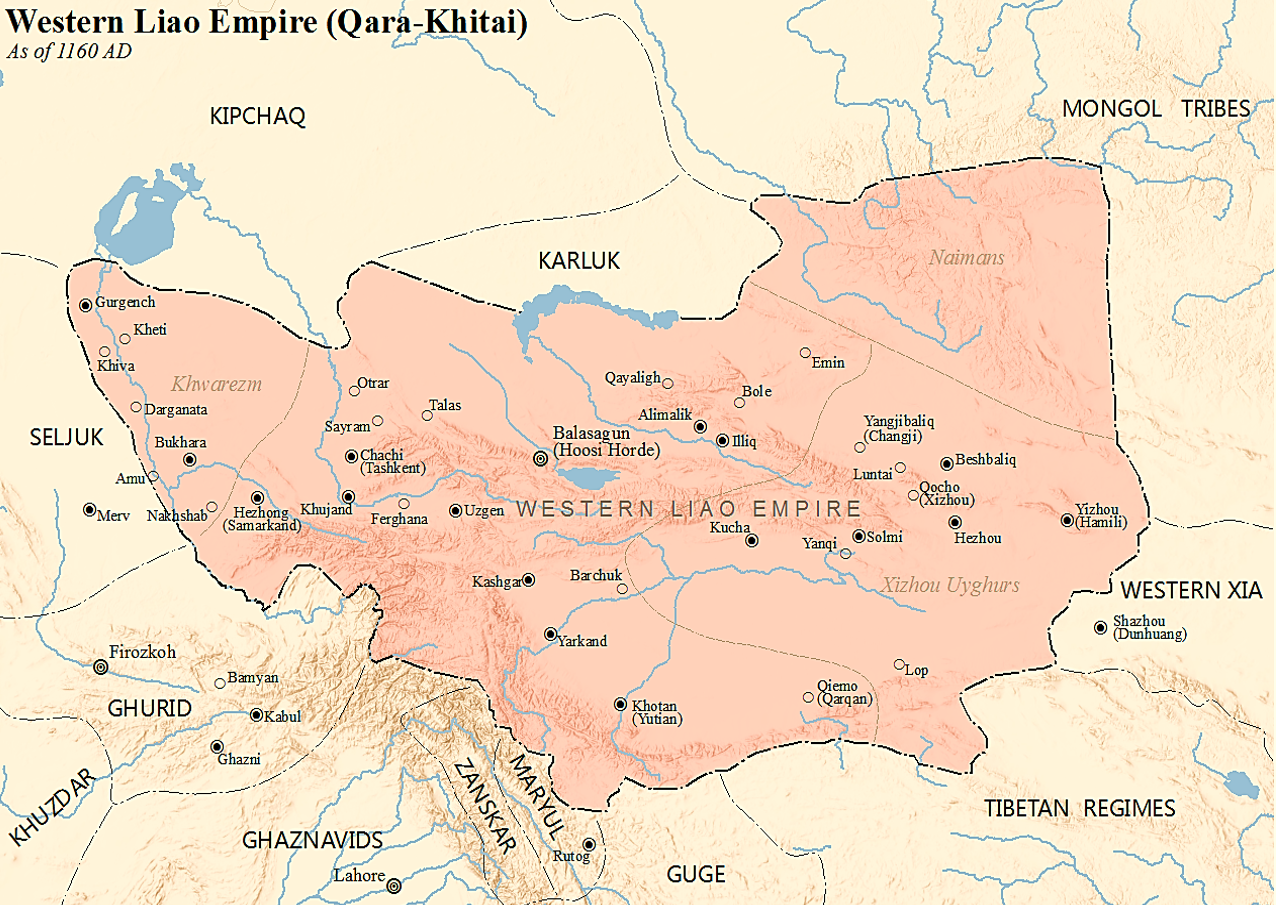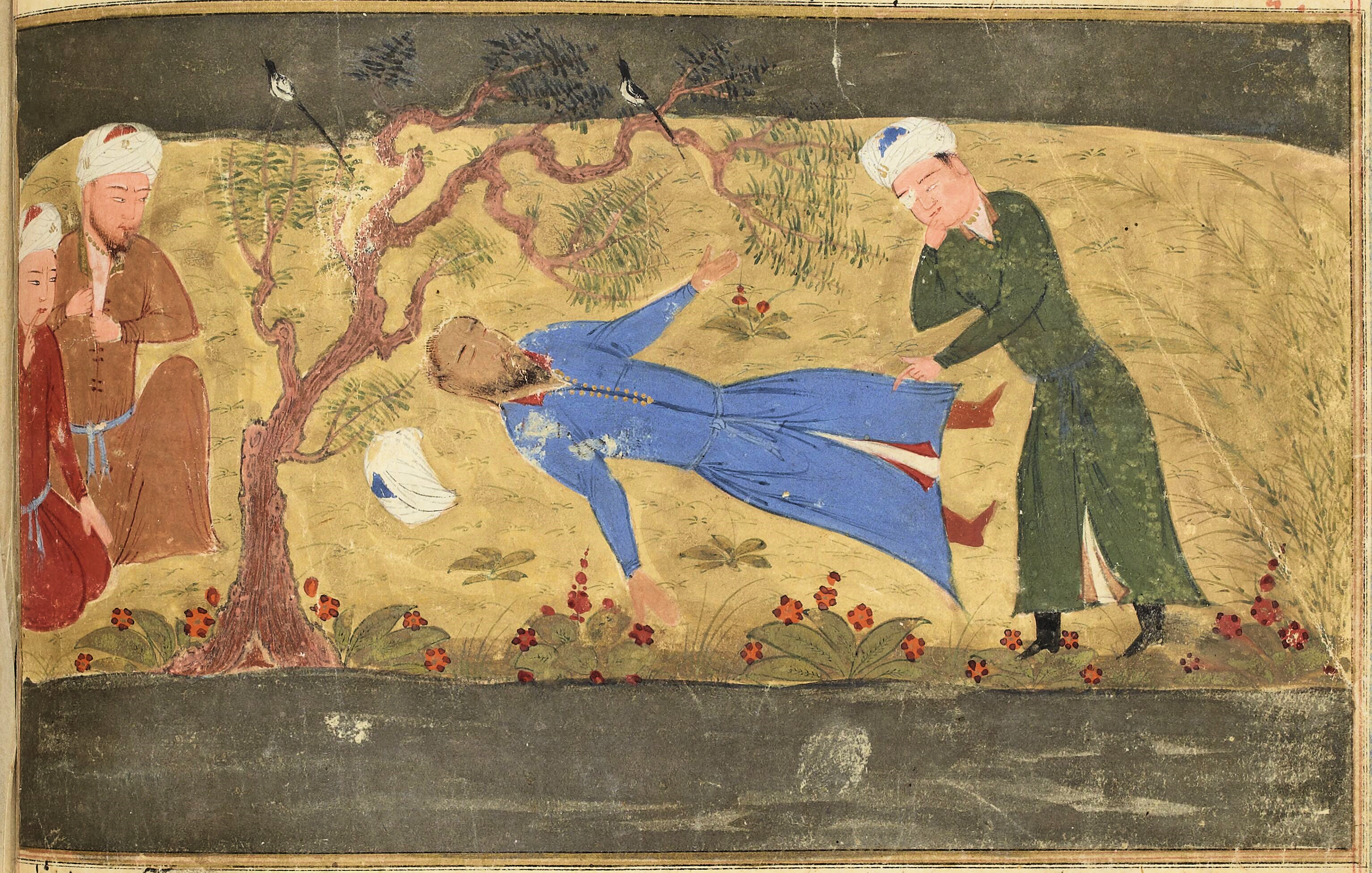|
Küchlüg
Kuchlug (also spelled ''Küchlüg'', ''Küçlüg'', ''Güčülüg'', ''Quqluq'') ( mn, Хүчлүг; ; d. 1218) was a member of the Naiman tribe who became the last ruler of the Western Liao dynasty (Qara Khitai). The Naimans were defeated by Genghis Khan and he fled westward to the Qara Khitai, where he became an advisor to his future father-in-law Yelü Zhilugu. He later rebelled, usurped the throne and took control of the empire, putting an end to the rule of the House of Yelü. He was killed in 1218 by the Mongols and the domain of the Qara Khitai was absorbed into the Mongol Empire. While his predecessor Yelü Zhilugu was the last Qara Khitai emperor from the Yelü clan, Kuchlug is sometimes regarded as the final ruler of the Western Liao realm as he retained the dynastic title of "Great Liao" upon his ascension to the throne. Naiman origins and westward flight Kuchlug was the son of Taibuqa, the Tayang khan (leader) of the Naimans, a Mongol-speaking tribe. In 1204, Ja ... [...More Info...] [...Related Items...] OR: [Wikipedia] [Google] [Baidu] |
Naimans
The Naiman ( Mongolian: Найман, Naiman, "eight"; ; Kazakh: Найман, Naiman; Uzbek: Nayman) were a medieval tribe originating in the territory of modern Western Mongolia (possibly during the time of the Uyghur Khaganate), and are one of the tribes of modern Mongols and in the middle juz of the Kazakh nation. History In ''The Secret History of the Mongols'', the Naiman subtribe the "Güchügüd" are mentioned. According to Russian Turkologist Nikolai Aristov's view, the Naiman Khanate's western border reached the Irtysh River and its eastern border reached the Mongolian Tamir River. The Altai Mountains and southern Altai Republic were part of the Naiman Khanate. They had diplomatic relations with the Kara-Khitans, and were subservient to them until 1175. In the Russian and Soviet historiography of Central Asia they were traditionally ranked among the Mongol-speaking tribes. For instance, such Russian orientalists as Vasily Bartold, Grigory Potanin, Boris Vladimirtsov ... [...More Info...] [...Related Items...] OR: [Wikipedia] [Google] [Baidu] |
Emperor Of China
''Huangdi'' (), translated into English as Emperor, was the superlative title held by monarchs of China who ruled various imperial regimes in Chinese history. In traditional Chinese political theory, the emperor was considered the Son of Heaven and the autocrat of all under Heaven. Under the Han dynasty, Confucianism replaced Legalism as the official political theory and succession in most cases theoretically followed agnatic primogeniture. The lineage of emperors descended from a paternal family line constituted a dynasty. The absolute authority of the emperor came with a variety of governing duties and moral obligations; failure to uphold these was thought to remove the dynasty's Mandate of Heaven and to justify its overthrow. In practice, emperors sometimes avoided the strict rules of succession and dynasties' ostensible "failures" were detailed in official histories written by their successful replacements. The power of the emperor was also limited by the imperial burea ... [...More Info...] [...Related Items...] OR: [Wikipedia] [Google] [Baidu] |
Temüjin
''Chinggis Khaan'' ͡ʃʰiŋɡɪs xaːŋbr />Mongol script: ''Chinggis Qa(gh)an/ Chinggis Khagan'' , birth_name = Temüjin , successor = Tolui (as regent)Ögedei Khan , spouse = , issue = , house = Borjigin , dynasty = Genghisid , regnal name = Genghis Khan () , temple name = Taizu () , posthumous name = Emperor Fatian Qiyun Shengwu () , father = Yesügei , mother = Hoelun , religion = Tengrism , birth_date = , birth_place = Khentii Mountains, Khamag Mongol , death_date = (aged 64–65) , death_place = Xingqing, Western Xia , burial_place = Unknown(presumptively Ikh Khorig, Burkhan Khaldun, Khentii Province) Genghis Khan (born Temüjin; ; xng, Temüjin, script=Latn; ., name=Temujin – August 25, 1227) was the founder and first Great Khan (Emperor) of the Mongol Empire, which became the largest contiguous empire in history after his death. He came to power by uniting many of the nomadic tribes of the ... [...More Info...] [...Related Items...] OR: [Wikipedia] [Google] [Baidu] |
Taraz
Taraz ( kz, Тараз, تاراز, translit=Taraz ; known to Europeans as Talas) is a city and the administrative center of Jambyl Region in Kazakhstan, located on the Talas (river), Talas (Taraz) River in the south of the country near the border with Kyrgyzstan. It had a population of 330,100 as of the 1999 census, up 9% from 1989, making it one of the fastest-growing cities in the country, after Astana and Turkistan (city), Turkistan. One of the oldest cities in Kazakhstan and in Transoxania, built and populated by the ancient Sogdians, Taraz celebrated its official 2,000th anniversary (recognized by UNESCO) in 2001, dating from a fortress built in the area by a Xiongnu Chanyu named Zhizhi, and was a site of the Battle of Zhizhi in 36 BCE. The city was first recorded under the name "Talas" in 568 CE by Menander Protector. The medieval city of Talas was a major trade centre along the Silk Road. Talas was later described by Buddhist monk and traveller Xuanzang, who passed Talas i ... [...More Info...] [...Related Items...] OR: [Wikipedia] [Google] [Baidu] |
Karakhanids
The Kara-Khanid Khanate (; ), also known as the Karakhanids, Qarakhanids, Ilek Khanids or the Afrasiabids (), was a Turkic khanate that ruled Central Asia in the 9th through the early 13th century. The dynastic names of Karakhanids and Ilek Khanids refer to royal titles with Kara Khagan being the most important Turkic title up until the end of the dynasty. The Khanate conquered Transoxiana in Central Asia and ruled it between 999 and 1211. Their arrival in Transoxiana signaled a definitive shift from Iranian to Turkic predominance in Central Asia, yet the Kara-khanids gradually assimilated the Perso-Arab Muslim culture, while retaining some of their native Turkic culture. The capitals of the Kara-Khanid Khanate included Kashgar, Balasagun, Uzgen and Samarkand. In the 1040s, the Khanate split into the Eastern and Western Khanates. In the late 11th century, they came under the suzerainty of the Seljuk Empire, followed by the Qara Khitai (Western Liao dynasty) in the mid-12t ... [...More Info...] [...Related Items...] OR: [Wikipedia] [Google] [Baidu] |
Samarkand
fa, سمرقند , native_name_lang = , settlement_type = City , image_skyline = , image_caption = Clockwise from the top:Registan square, Shah-i-Zinda necropolis, Bibi-Khanym Mosque, view inside Shah-i-Zinda, Sher-Dor Madrasah in Registan, Timur's Mausoleum Gur-e-Amir. , image_alt = , image_flag = , flag_alt = , image_seal = Emblem of Samarkand.svg , seal_alt = , image_shield = , shield_alt = , etymology = , nickname = , motto = , image_map = , map_alt = , map_caption = , pushpin_map = Uzbekistan#West Asia#Asia , pushpin_map_alt = , pushpin_mapsize = 300 , pushpin_map_caption = Location in Uzbekistan , pushpin_label_position = , pushpin_relief = 1 , coordinates = , coor_pinpoint = , co ... [...More Info...] [...Related Items...] OR: [Wikipedia] [Google] [Baidu] |
Bukhara
Bukhara (Uzbek language, Uzbek: /, ; tg, Бухоро, ) is the List of cities in Uzbekistan, seventh-largest city in Uzbekistan, with a population of 280,187 , and the capital of Bukhara Region. People have inhabited the region around Bukhara for at least five millennia, and the city has existed for half that time. Located on the Silk Road, the city has long served as a center of trade, scholarship, culture, and religion. The mother tongue of the majority of people of Bukhara is Tajik language, Tajik, a dialect of the Persian language, although Uzbek language, Uzbek is spoken as a second language by most residents. Bukhara served as the capital of the Samanid Empire, Khanate of Bukhara, and Emirate of Bukhara and was the birthplace of scholar Imam Bukhari. The city has been known as "Noble Bukhara" (''Bukhārā-ye sharīf''). Bukhara has about 140 architectural monuments. UNESCO has listed the historic center of Bukhara (which contains numerous mosques and madrasas) as a List o ... [...More Info...] [...Related Items...] OR: [Wikipedia] [Google] [Baidu] |
Khwarazmian Empire
The Khwarazmian or Khwarezmian Empire) or the Khwarazmshahs ( fa, خوارزمشاهیان, Khwārazmshāhiyān) () was a Turko-Persian Sunni Muslim empire that ruled large parts of present-day Central Asia, Afghanistan, and Iran in the approximate period of 1077 to 1231, first as vassals of the Seljuk Empire and the Qara Khitai (Western Liao dynasty), and later as independent rulers, up until the Mongol conquest in the 13th century. It is estimated that the empire spanned an area of 2.3 million square kilometers to 3.6 million square kilometers effectively making it one of the largest land empires in history. In the beginning of the 13th century, the empire was the greatest power in the Muslim world. The empire, which was modelled on the preceding Seljuk Empire, was defended by a huge cavalry army composed largely of Kipchak Turks. However, in 1219, the Mongols under their ruler Genghis Khan invaded the Khwarazmian Empire, successfully conquering the whole of it in just t ... [...More Info...] [...Related Items...] OR: [Wikipedia] [Google] [Baidu] |
Muhammad II Of Khwarezm
Ala ad-Din Muhammad II (Persian: علاءالدین محمد خوارزمشاه; full name: ''Ala ad-Dunya wa ad-Din Abul-Fath Muhammad Sanjar ibn Tekish'') was the Shah of the Khwarazmian Empire from 1200 to 1220. His ancestor was Anushtegin Gharchai, a Turkic Ghulam who eventually became a viceroy of a small province named Khwarizm. He is perhaps best known for inciting the Mongol conquest of the Khwarazmian Empire, which resulted in the utter destruction of his empire. Reign After his father Tekish died, Muhammad succeeded him. Right after his accession, however, his domains were invaded by the two Ghurid brothers Ghiyath al-Din Ghori and Mu'izz al-Din. Within weeks, the two brothers had moved their armies westwards into Khorasan. Once they had captured Nishapur, Mu'izz al-Din was sent on an expedition towards Ray, but he let his troops get out of control and got little further than Gurgan, earning criticism from Ghiyath which led to the only reported quarrel between the bro ... [...More Info...] [...Related Items...] OR: [Wikipedia] [Google] [Baidu] |
Western Liao
The Qara Khitai, or Kara Khitai (), also known as the Western Liao (), officially the Great Liao (), was a Sinicized dynastic regime based in Central Asia ruled by the Khitan Yelü clan. The Qara Khitai is considered by historians to be an orthodox dynasty of China, as is the case for its predecessor the Liao dynasty. The dynasty was founded by Yelü Dashi (Emperor Dezong), who led the remnants of the Liao dynasty from Manchuria to Central Asia after fleeing from the Jin dynasty conquest of their homeland in northern China. The empire was usurped by the Naimans under Kuchlug in 1211; traditional Chinese, Persian, and Arab sources consider the usurpation to be the end of the dynasty, even though the empire would not fall until the Mongol conquest in 1218. The territories of the Qara Khitai corresponded to parts of modern-day China, Kazakhstan, Kyrgyzstan, Mongolia, Tajikistan, and Uzbekistan. The Anushtegin dynasty, the Karluks, Qocho, the Kankalis, and the Kara-Khanid Kh ... [...More Info...] [...Related Items...] OR: [Wikipedia] [Google] [Baidu] |
Balasagun
Balasagun ( or ''Balasagyn''; ) was an ancient Sogdian city in modern-day Kyrgyzstan, located in the Chüy Valley between Bishkek and the Issyk-Kul lake. Located along the Silk Road, the ruins of the city were inscribed in 2014 on the UNESCO World Heritage List as part of the Silk Roads: the Routes Network of Chang'an-Tianshan Corridor World Heritage Site. Balasagun was founded by the Sogdians, a people of Iranian origin and the Sogdian language was still in use in this town until the 11th century. It was the capital of the Kara-Khanid Khanate from the 10th century until it was taken by the Qara Khitai (Western Liao dynasty) in 1134. It was then captured by the Mongols in 1218. The Mongols called it Gobalik "Pretty City". It should not be confused with Karabalghasun, now Ordu-Baliq in Mongolia, which was the capital of the Uyghur Khaganate. Founded by the Kara-Khanid Khanate in the ninth century, Balasagun soon supplanted Suyab as the main political and economical centre of t ... [...More Info...] [...Related Items...] OR: [Wikipedia] [Google] [Baidu] |









